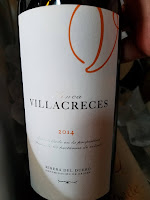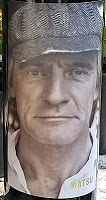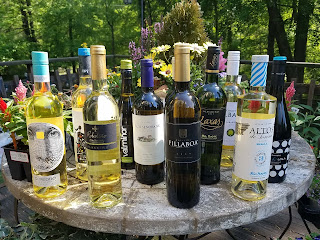Many wine consumers are probably familiar with the Designation of Origin (D.O.) Ribera del Duero wine region, situated in north-central Spain, roughly two hours north of Madrid. This classic region in Castilla y León sits on an elevated plateau along, not surprisingly, 70 miles of the Duero River before it meanders to Portugal and its outlet to the Atlantic at Porto. The summers in Ribero are long, hot, and dry with the river providing irrigation relief. Red wine is king which usually means 100% Tinto Fino aka Tempranillo -- although at times wines may include Cabernet Sauvignon, Merlot, and Malbec. Aging requirements mandate that Crianzas spend one year aging in barrel with one year in bottle whereas Reservas spend an additional second year in bottle before release. And Gran Reservas require at least two years in barrel and three years aging in bottle. These wines tend to be rich and powerful with acidity to match.

Less familiar is Ribera's companion wine region Rueda -- also located in Castilla y León but situated to the southwest and where wine production dates back to the 12th century. Spain's wine drinkers are more familiar since Rueda received D.O. designation before Ribera, 1980 versus 1982. The older D.O. hosts a continental climate with abundant sunlight, low rainfall, and prevailing winds that dry the vineyards. This allows for practically organic viticulture. And in contrast to Ribera, white grapes dominate as in Spain’s most popular white grape Verdejo. Not only does Verdejo thrive in these conditions but the large diurnal temperature swings of 50 degrees on average maintain the balance between sugar and acidity. This is why the grape was replanted extensively in the 1970's after being decimated in the region in the late 19th century due to phylloxera.
This month the marketing arm of the twin regions,
Ribera y Rueda, hosted a series of trade tastings with one held at the
Barcelona Wine Bar in Washington D.C.. This event showcased Tempranillo and Verdejo from 28 wineries in order to present "wines that reflect an ancient tradition and a singular sense of place, yet have a timeless appeal that knows no borders". With such a large tasting it is difficult to fully experience all presenters so here are a handful that caught my attention.
Starting with Rueda, the
Bodega Javier Sanz Viticultor presented two Verdejo wines that were fantastic. The winery owns 104 hectares of vines, many pre-phylloxera vineyards, with the intent to cultivate local grape varieties and the recovery of varieties that almost became extinct. One of these is Malcorta, a Verdejo clone nursed from virtual extinction and the basis for the
Javier Sanz Viticultor V Malcorta 2016 ($28). This is an elegant wine, aged six months on lees and possessing a creamy dry character with minerals and nuts finishing with abundant acidity. The also showed the
Javier Sanz Viticultor Verdejo 2017 ($20) that spent four months on lees providing a little texture to accompany the refreshing finish. A similar wine was poured by
Bodegas Menade with their
Menade Verdejo 2016 ($15) that provides racy minerals with a large mouth feel. Other notables are the
Marqués de Cáceres Verdejo 2016 ($13), the
Familia Torres Verdejo 2016 ($12), and the
Hermano del Villar Oro De Castilla Verdejo 2017 ($17).
Bodega Reina de Castilla is a cooperative of family vineyards producing several styles of Verdejo as well as Sauvignon Blanc. Their entry level
Bodega Reina de Castilla Isabelino Rueda 2017 ($11) includes some Viura, is made from 35 year old vines, and rather tasty. But try to locate their
Bodega Reina de Castilla Barrel Fermented Verdejo 2016 ($23) that is made from 50 year old vines only in exceptional years. This wine show depth and elegance with a silky, refreshing tail.
 Bodegas Mocén
Bodegas Mocén is located in the old center of the village of Rueda and like Reina de Castilla produces an excellent Sauvignon Blanc as well as the barrel fermented
Bodegas Mocén Fermentado en Barrica 2016 ($25). This wine has more oak presence with vanilla and spice but also retains the traditional green apple and fresh acids. They also poured an organic equivalent
Bodegas Mocén Ecologico 2016 ($15) that possesses plenty of texture and minerals with a little less acids.

For Ribera, let's start with
Viñedos y Bodegas Gormaz, one of the nine founding members of the Ribera del Duero D.O. that itself was founded in 1972. It sources fruit from small vineyards throughout the eastern part of Ribera that are the foundation of three excellent 12 Lineages wines poured that day:
Viñedos y Bodegas Gormaz 12 Linajes Roble 2014 ($18),
Viñedos y Bodegas Gormaz 12 Linajes Crianza 2011 ($24), and
Viñedos y Bodegas Gormaz 12 Linajes Reserva 2009 ($35). These wines had various shades of spice and tannins - but are three powerful and delicious wines.

For 25 years April Cullom has been an evangelist for Spanish wine and recently launched the
Alma de Vino brand to celebrate Ribera. The
Alma de Vino Old Vine Tempranillo 2011 ($35) is made from old vine organic grapes grown at some of the highest elevations in Ribera. This leads to a higher diurnal swing allowing he grapes to ripen slower resulting in softer tannins. An excellent wine.
 Finca Villacreces
Finca Villacreces is named after the Franciscan monk Pedro de Villacreces who founded the estate in the 14th century. This property consists of 64 hectares of vines located in the heart of the Ribera del Duero's "Golden Mile". Their
Finca Villacreces 2014 ($39) is a blend of 86% Tempranillo, 10% Cabernet Sauvignon, 4% Merlot aged 14 months in new oak. Quite simply, it is fantastic: structured, good fruit, slight spice and rounded tannins.
 Dominio Basconcillos
Dominio Basconcillos offers soft Tempranillo wines through their organic and biodynamic practices on their 18 year old winery. The grapes are grown at over 3,000 feet in elevation providing similar slow ripening and these soft tannins. So check out the
Dominio Basconcillos Vina Magna Seie Meses 2016 ($26) and
Dominio Basconcillos Vina Magna 2015 ($40).

The final wines are from
Bodegas Peñalba Herráiz and
Bodegas Arrocal. The former owns vineyards located in Aranda de Duero, Castrillo de la Vega and Hoyales de Roa and their
Bodegas Peñalba Herráiz Aptus 2015 ($17) is a soft and structured blend of Tempranillo, Garnacha, and Monestrell. The latter is a family owned winery farming their ancestry vineyards with the
Bodegas Arrocal Seleccion 2014 ($40) based on 70 year old vines. This is an impressive wine with a solid backbone, dark fruit, and slight spice.
There were plenty of other delicious wines from Ribera Y Rueda. Start your research into the two areas now. Cheers.
 Castilla y León is the largest region of Spain, as well the largest region of all the European Union, and hosts the wine regions of Ribera and Rueda in addition to the more recently designated Toro DO. Toro lies to the west of Rueda in the province of Zamora and and is bisected by the Duero River flowing towards Portugal. Despite gaining Denomination of Origin (DO) status as late as 1987, wine making traditions predate the Romans as Greek settlers taught the local Celtic tribes how to vinify grapes. During the Middle Ages, Toro gained considerable wealth from the wine trade which expanded during the phylloxera epidemic as the local vines were protected by the sandy soil. Thus even today there are 150 year old vines still producing fruit. Traditionally Tinta de Toro refers to red wine from Toro and equates to a clone of the Tempranillo grape that excels in the DO's continental climate. Like other Spanish DOs there are several classifications of Tinta de Toro:
Castilla y León is the largest region of Spain, as well the largest region of all the European Union, and hosts the wine regions of Ribera and Rueda in addition to the more recently designated Toro DO. Toro lies to the west of Rueda in the province of Zamora and and is bisected by the Duero River flowing towards Portugal. Despite gaining Denomination of Origin (DO) status as late as 1987, wine making traditions predate the Romans as Greek settlers taught the local Celtic tribes how to vinify grapes. During the Middle Ages, Toro gained considerable wealth from the wine trade which expanded during the phylloxera epidemic as the local vines were protected by the sandy soil. Thus even today there are 150 year old vines still producing fruit. Traditionally Tinta de Toro refers to red wine from Toro and equates to a clone of the Tempranillo grape that excels in the DO's continental climate. Like other Spanish DOs there are several classifications of Tinta de Toro:
















































